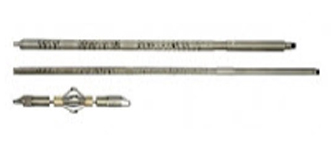Empire Wireline of Kansas
Over 100 Years Experience
Located in McPherson, KS within 15 miles of 70% of all Kansas storage operations. Empire Wireline is the ONLY KDHE approved through tubing casing inspection company. Empire continues to set the standard for cased hole logging in Kansas.
If you have a question, service request or technical assistance please contact Tim Sauce 337-940-0718
Let us show you the Empire advantage!
The Multi-Finger Caliper (MFC) has 24 to 60 high resolution calipers which measures the internal radii of the wellbore tubing and casing. Accurate measurements can be made in tubular sizes from 1.75 inches to 20 inches in diameter. The MFC uses a series of “contactless” displacement sensors and a corresponding number of measurement fingers. When moving along the inner casing wall, the radial displacement will be changed into an axial displacement of the sensor, which is then processed, coded, and transferred to surface system where the image of the casing will be obtained.
Empire Special Services was formed to fill a void in the casing inspection market. Our personnel has over 60 years combined experience and are backed by the most technologically advanced casing inspection hardware and software in the industry. Empire is currently the only company operating in North America with the capability to provide our customers a full casing inspection survey by means of a point to point internal reading via a multi finger caliper (MFC), and an external corrosion assessment by means of our electromagnetic thickness tool (EMT). Our EMT has the capability of providing the client a true corrosion assessment without having the influence of another, outer tubing string in the hole. In addition, our EMT can provide the client an assessment of the outer casing as well as the inner casing during the same trip in the hole.
The following descriptions are just a sample of our tools and capabilities.
Electromagnetic Tool Specifications:
- Tool OD – 1 11/16”
- Max Temp/Pressure 350F/15000PSI
- Length/Weight – 98.5”/51 lbs
- Logging Speed – 16’/min
- Pipe String Measurement
- Range – 2.362” – 20”
- Single Pipe Measurements:
- Pipe Wall Thickness – ≤ 0.4724” Measurement
- Error – ± 0.0197”
- Resolution – 0.0059”
- Double Pipe Measurement:
- Pipe Wall Thickness – ≤ 0.984”
- Measurement Error – ± 0.059”
- Resolution – 0.0118”
PULSE NEUTRON NEUTRON TOOL (PNN) measures sigma, the ability of material to capture thermal Neutrons, in capture units (c.u.).
PNN directly counts the thermal neutrons reaching the detectors after their interaction with the surrounding formation; then, the usual inference by common thermal decay tools that count Gamma rays where High-counts means high-sigma-Values changes by the PNN tool into High-counts means low-sigma-Values, and it has the significance of obtaining statistical uncertainties reduction for low sigma values. this sole measuring approach allows better differentiation in environments of low sigma values, which is the case when fresh water, oil and/or gas are present in the pore spaces, overcoming by this way, the low salinity formation water problem which appears as a limitation factor of standard thermal Decay time tools; additionally, Neutron readings are less affected by Neutron activation, hence, logging of time-driven stop-Checks in area of interest helps reduce the statistical uncertainties of readings at any de-sired depth spot. All of this makes PNN tool, in conjunction with our PNN processing and analysis software, a competitive behind-casing formation evaluation tool for high to moderate water salinity formations and the ultimate thermal decay tool for evaluation of lower salinity and lower porosity formations.
Application
Water saturation behind casing, porosity, remaining Hydrocarbon reserves estimation, oil-water, gas-water and gas-oil contacts location, etc.
Operation
The formation is bombarded with pulses of high-energy neutrons (14 MeV) generated by the tool. Neutrons interact with the surrounding atoms and, during the lapse of time between high-energy neutron pulses, the thermal neutron population that reaches the Neutron detectors is sampled by two detectors with 60 time channels each; Per Channel Neutrons counted are used to compute the rate of decay, it is equivalent to measuring the rate at which thermal neu-trons are absorbed into the formation, the greater fluids and minerals capture thermal neutrons, the higher the value of sigma.

Cement bond tools measure the bond between casing and the cement placed in the annulus between the casing and the wellbore. Empire utilizes both 8 and 16 sector bond tools which allows us to provide clients with tubings from 4″ to 22″ a proper cemented casing evaluation.The measurement is made by using acoustic sonic.
The measurements of industry-standard sonic tools are usually displayed on a cement bond log (CBL) in millivolt units, decibel attenuation, or both. Reduction of the reading in millivolts or an increase in the decibel attenuation is an indication of better-quality bonding of the cement behind the casing to the casing wall.

